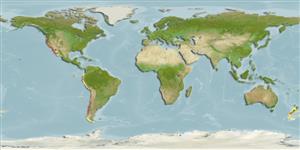Environment: milieu / climate zone / depth range / distribution range
Ökologie
seewasser; brackwasser demersal; tiefenbereich 0 - 280 m (Ref. 34024). Subtropical; 47°N -
Eastern Pacific: Washington, USA to Baja California and Ecuador. Record from the Gulf of California is doubtful.
Size / Gewicht / Alter
Maturity: Lm ? range ? - ? cm
Max length : 40.4 cm TL Männchen/unbestimmt; (Ref. 30541); common length : 30.0 cm TL Männchen/unbestimmt; (Ref. 55763)
Kurzbeschreibung
Bestimmungsschlüssel | Morphologie | Morphometrie
Rückenflossenstacheln (insgesamt) : 0; Rückenflossenweichstrahlen (insgesamt) : 187 - 229; Afterflossenstacheln: 0; Afterflossenweichstrahlen: 150 - 181; Wirbelzahl: 86 - 91. Head naked; scales on body in basketweave pattern; precaudal vertebrae 18-19; swim bladder in males with posterior opening; body and head with numerous dark spots and blotches (Ref. 34024). Branchiostegal rays: 7 (Ref. 36413). Pelvic fin consists of one ray with two branches of unequal length (Ref. 36413).
Uncommon species found on sandy bottom from the shore to 280 m (Ref. 34024). Adults often burrow tail-first in sand, live in mucus-lined holes (Ref. 2850), mud, eelgrass and rock rubble (Ref. 36413). Mostly active at night and on overcast days (Ref. 2850). Important food for sea lions and cormorants (Ref. 2850). Oviparous, with planktonic larvae and extended pelagic juvenile (Ref. 36413). Oval, pelagic eggs float in a gelatinous mass (Ref. 205).
Nielsen, J.G., D.M. Cohen, D.F. Markle and C.R. Robins, 1999. Ophidiiform fishes of the world (Order Ophidiiformes). An annotated and illustrated catalogue of pearlfishes, cusk-eels, brotulas and other ophidiiform fishes known to date. FAO Fish. Synop. 125(18):178p. Rome: FAO. (Ref. 34024)
IUCN Rote Liste Status (Ref. 130435)
Bedrohung für Menschen
Harmless
Nutzung durch Menschen
Fischereien: nicht kommerziell
Tools
Zusatzinformationen
Download XML
Internet Quellen
Estimates based on models
Preferred temperature (Ref.
123201): 9.3 - 15.1, mean 11.3 °C (based on 51 cells).
Phylogenetic diversity index (Ref.
82804): PD
50 = 1.0000 [Uniqueness, from 0.5 = low to 2.0 = high].
Bayesian length-weight: a=0.00102 (0.00046 - 0.00225), b=3.06 (2.88 - 3.24), in cm total length, based on all LWR estimates for this body shape (Ref.
93245).
Trophic level (Ref.
69278): 4.1 ±0.57 se; based on food items.
Generation time: 2.9 ( na - na) years. Estimated as median ln(3)/K based on 1
growth studies.
Widerstandsfähigkeit (Ref.
120179): mittel, Verdopplung der Population dauert 1,4 - 4,4 Jahre. (K=0.3).
Fishing Vulnerability (Ref.
59153): Low to moderate vulnerability (32 of 100).
